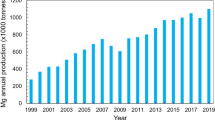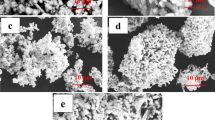Abstract
Glass-forming ability (GFA) in relation to microstructure evolution in the ternary Fe–Nb–B and Fe–Zr–B and quaternary Fe–(Nb,Zr)–B systems was systematically studied in a three-dimensional composition space. Through navigating, it was revealed that alloys with the optimum glass-forming ability (GFA) are coupled with composition regions surrounded by competing crystalline phases. Alloys Fe71Nb6B23, Fe77Zr4B19, and Fe71(Nb0.8Zr0.2)6B23 were illustrated to be the best glass formers in the ternary Fe–Nb–B and Fe–Zr–B systems and the quaternary Fe–(Nb,Zr)–B system, respectively, with a critical size for amorphous formation up to 2 mm. They were compared with the theoretical predictions on the basis of an efficient dense-packing model, and good agreements were obtained.
















Similar content being viewed by others
References
A. Inoue, Y. Shinohara J.S. Gook: Thermal and magnetic properties of bulk Fe-based glassy alloys prepared by copper mold casting. Mater. Trans., JIM 36, 1427 1995
A. Inoue J.S. Gook: Effect of additional elements (M) on the thermal stability of supercooled liquid in Fe72–xAl5Ga2P11C6B4Mx glassy alloys. Mater. Trans., JIM 37, 32 1996
A. Inoue, A. Murakami, T. Zhang A. Takeuchi: Thermal stability and magnetic properties of bulk amorphous Fe-Al-Ga-P-C-B-Si alloys. Mater. Trans., JIM 38, 189 1997
B.L. Shen, H. Koshiba, T. Mizushima A. Inoue: Bulk amorphous Fe-Ga-P-B-C alloys with a large supercooled liquid region. Mater. Trans., JIM 41, 873 2000
T.D. Shen R.B. Schwarz: Bulk ferromagnetic glasses prepared by flux melting and water quenching. Appl. Phys. Lett. 75, 49 1999
A. Inoue, T. Zhang A. Takeuchi: Bulk amorphous alloys with high mechanical strength and good soft magnetic properties in Fe-TM-B (TM = IV–VIII group transition metal) system. Appl. Phys. Lett. 71, 464 1997
B.L. Shen, A. Inoue C.T. Chang: Superhigh strength and good soft-magnetic propertied of (Fe, Co)-B-Si-Nb bulk glassy alloys with high glass-forming ability. Appl. Phys. Lett. 85, 4911 2004
A. Inoue, B.L. Shen C.T. Chang: Super-high strength of over 4000 MPa for Fe-based bulk glassy alloys in [(Fe1–xCox)0.75B0.2Si0.05]96Nb4 system. Acta Mater. 52, 4093 2004
K. Amiya, A. Urata, N. Nishiyama A. Inoue: Fe-B-Si-Nb bulk metallic glasses with high strength above 4000 MPa and distinct plastic elongation. Mater. Trans., JIM 45, 1214 2004
V. Ponnambalam, S.J. Poon, G.J. Shiflet, V.M. Keooens, R. Taylor G. Petculescu: Synthesis of iron-based bulk metallic glass as nonferromagnetic amorphous steel alloys. Appl. Phys. Lett. 83, 1131 2003
V. Ponnambalam, S.J. Poon G.J. Shiflet: Fe-based bulk metallic glass with diameter thickness larger than one centimeter. J. Mater. Res. 19, 1320 2004
V. Ponnambalam, S.J. Poon G.J. Shiflet: Fe-Mn-Cr-Mo-(Y,Ln)-C-B (Ln = lanthanides) bulk metallic glasses as formable amorphous steel alloys. J. Mater. Res. 19, 3046 2004
Z.P. Lu, C.T. Liu, J.R. Thompson W.D. Porter: Structural amorphous steels. Phys. Rev. Lett. 92, 245503 2004
J. Shen, Q.J. Chen, J.F. Sun, H.B. Fan G. Wang: Exceptionally high glass forming ability of an FeCoCrMoCBY alloy. Appl. Phys. Lett. 86, 151907 2004
J. Zhang, H. Tan, Y.P. Feng Y. Li: The effect of Y on glass forming ability. Scripta Mater. 53, 183 2005
C.Y. Lin, H.Y. Tien T.S. Chin: Soft magnetic ternary iron-boron-based bulk metallic glasses. Appl. Phys. Lett. 86, 162501 2005
A. Zhu, G. Shiflet D.B. Miracle: Glass forming ranges of Al–rare earth metal alloys: Thermodynamic and kinetic analysis. Scripta Mater. 50, 987 2004
H.J. Fecht, P.J. Desre W.L. Johnson: Thermodynamic aspects of solid-State amorphization: Polymorphous melting clapeyron diagram. Philos. Mag. B 5, 577 1989
T. Egami: The atomic structure of aluminum based metallic glasses and universal criterion for glass formation. J. Non-Cryst. Solids 205–207, 575 1996
H. Tan, Y. Zhang, D. Ma, Y.P. Feng Y. Li: Optimum glass formation at off-eutectic composition and its relation to skewed eutectic coupled zone in the La based La-Al-(Cu,Ni) pseudo ternary system. Acta Mater. 51, 4551 2003
D. Wang, Y. Li, B.B. Sun, M.L. Sui, K. Lu E. Ma: Bulk metallic glass formation in the binary Cu-Zr system. Appl. Phys. Lett. 84, 4029 2004
D. Wang, H. Tan Y. Li: Multiple maxima of GFA in three adjacent eutectics in Zr–Cu–Al alloy system: A metallographic way to pinpoint the best glass forming alloys. Acta Mater. 53, 2969 2005
P. Villars, A. Prince H. Okamoto: Handbook of Ternary Alloy Phase Diagrams ASM International Materials Park, OH 1997
D. Turnbull: Under what conditions can a glass be formed. Contemp. Phys. 10, 473 1969
O.N. Senkov D.B. Miracle: Effect of the atomic size distribution on glass forming ability of amorphous metallic alloys. Mater. Res. Bull. 36, 2183 2001
D.B. Miracle: The efficient cluster packing model: An atomic structure model for metallic glasses. Acta Mater. 54, 4317 2006
A.P. Wang, J.Q. Wang E. Ma: Modified efficient cluster packing model for calculating alloy compositions with high glass forming ability. Appl. Phys. Lett. 90, 121912 2007
A. Takeuchi A. Inoue: Calculations of mixing enthalpy and mismatch entropy for ternary amorphous alloys. Mater. Trans., JIM 41, 1372 2000
M. Stoica, K. Hajlaoui, A. Lemoulec A.R. Yavari: New ternary Fe-based bulk metallic glass with high boron content. Philos. Mag. Lett. 86, 267 2006
A.L. Greer: Metallic glasses. Science 267, 1947 1995
Acknowledgments
This research was supported by the National Natural Science Foundation of China (Grant Nos. 50471076 and 50323009). The authors are also with the Multi-component Amorphous and Nanocrystalline Systems (MANS) Research team, supported by the Chinese Academy of Sciences.
Author information
Authors and Affiliations
Corresponding authors
Rights and permissions
About this article
Cite this article
Yao, J., Yang, H., Zhang, J. et al. The influence of Nb and Zr on glass-formation ability in the ternary Fe–Nb–B and Fe–Zr–B and quaternary Fe–(Nb,Zr)–B alloy systems. Journal of Materials Research 23, 392–401 (2008). https://doi.org/10.1557/JMR.2008.0055
Published:
Issue Date:
DOI: https://doi.org/10.1557/JMR.2008.0055




